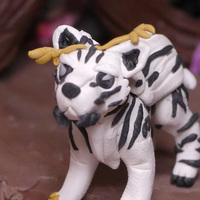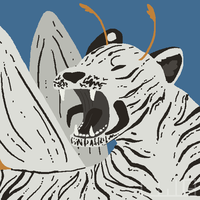Panthera insulanus
YeeshaStone
- Created
- 2 years, 3 months ago
- Creator
- SchoolMilkCarton
- Favorites
- 1
Profile

Panthera insulanus (a creature that is a mixture of a tiger and a white scarab[Cyphochilus insulanus]) are fierce beasts with sharp claws and striped fur. In contrast to their white, striped fur, their skin is jet black. They have a small set of orange wings under a thing, and white carpus on their backs, however, only juveniles are light enough for the wings to give them lift. As adults, they are too heavy but still use their wings to startle pray or intimidate foes. They will quickly open and close their bright-colored wings in succession in an attempt to confuse and scare those nearby. Some small, weak-willed targets have even been known to pass out or die from the shock of seeing them do this. They also have four sets of ears. Two larger ones towards the front of their heads and a set of smaller ones on the back of their heads. When hunting, they will swivel their ears around in all directions to best locate their prey. The set of larger ears also have a slightly odd coloration to them. The backs of them are black with a single white dot in the center of the blackness. It is thought that this dot can sometimes confuse those that pray on Panthera insulanus as at a quick glance, they look like an extra set of eyes, making it appear from both the front and the back as if Panthera insulanus has spotted them. They also have 3 pairs of small, sharp mandibles on either side of their mouths, helping them to grip tightly onto any creature that is unfortunate enough to be their prey. Once these sharp protrusions have sunk into a target, it is nearly impossible to get them out without losing the flesh they are hooked into. On their face, they also have two small orange-ish yellow antennae. These antennae not only help them to sense what direction the wind is blowing so they know how to stay downwind of their prey, but it also helps them to communicate to one another silently when out on a hunt. When not chasing after a target, though, they will use these antennae to help show their emotions to other Panthera insulanus. Because of this they are rather quiet creatures and will rarely make sounds unless startled.
Along with their four clawed paws, they also have an extra set of small Coloptera-like appendages near their chest area. These weak limbs assist them in eating as well as protecting food. However, their main use is actually to help them spread their scent. The small arms have a thin, white powder on them that, when smeared on objects, will leave behind a white color that stains the object. Not only is the object permanently stained, but given a little time, if the stained area is organic matter, then the white mark will also start to sprout white fungi. This fungus gives off a smell that only other Panthera insulanus can smell and is used by them as a way to mark their territory. If you spot white stripes of color in odd places, watch out, you have stumbled into their territory.

Most Panthera insulanus make their homes in large aspen forests where their striped fur helps them blend well against the black and white trees. They tend to live in packs of three to four Panthera insulanus, with the largest group recorded being 7. Most of the time, their packs are an equal ratio of males to females. They will often work together to knock down old trees that they will then pile into large heaps, giving them a place to rest that is protected from predators. Although their heaps aren't too organized, they do the job.

Panthera insulanus will hunt down any creatures that are around their size or smaller and will hunt in small groups of two. They will also gladly go after any creature who looks ill or hurt. Once a target is spotted, they will keep low to the ground and slowly get closer and closer to their prey. When the creature is within sprinting distance, they will suddenly dash for them, keeping their body low to the ground as they run until they are spotted. Once spotted, they will run as fast as they can and leap onto the target, sinking their claws, teeth, and mandibles into any vital spot they can as their hunting partner tries to keep any other nearby creatures in check before coming to their aid. Once the target is down, they will bring it back to their heap of trees, where they will share the spoils with those in their pack.

In the world of Animalia there are special traits and abilities that creatures and animalian alike possess. Upon death, these talents disappear. However, a particularly skilled hunter can preserve a creature's abilities past death, passing these talents onto any item that the creature is then used for, such as to be made into an article of clothing or used in a meal. Any Animalian who then consumes or uses these items will then gain the creature's abilities. Some of these items for this creature can be found here.

The creature sheet with full information on combat with a Panthera insulanus can be found here. Once you spot them, its already to late as within moments they will be ontop of you sinking their teeth into you.






